
Wondering if clipless or flats are right for you? Let’s take a minute and go through some of the differences and preferences that will help you define Clipless or Flats for MTB.
First let’s look at some pedaling basics that will help you whether you choose to ride clipped in or on platform pedals.
Good Pedaling Practices
Spinning Circles
Spin circles. Seems simple right? Ironically after all the years of riding this probably one of my least applied practices… I’m going to reference a clock face with 12 being straight up, 3 being forward and we’re talking about the drive side crank, clock reference is flipped for non-drive.
Ideally you’re using a combination of muscles and movements when you pedal your bike, not just smashing down in the say 1 to 4 o’clock positions. (I’m so guilty of that).
Now, whether you’re running clipless or flat pedals you can take advantage of spinning better circles. It’s more efficient, it’s easier on your body, it probably looks better (according to my riding buddies who give me a hard time). How does the concept work?
Even though there is clearly a position of the most power you can still “drive” the pedals throughout most of the pedal stroke whether you’re riding flats or clipless. On the bottom of the pedal stroke, like say 4 to 8 o’clock you “drag” your foot back. Think of it like a moonwalk move or scuffing your foot almost. On the top of the circle you’re pushing that “scuffing” until the pedal drops back into the optimum power position.
Does this add a ton to your speed? Nah. But it is more efficient (when I remember to do it) and it fires different muscles that in turn helps ease the load across the rest of your legs.
One of the things new riders imagine is that with clipless pedals you can “pull” up on the opposite of the power down stroke. And, sort of you can, but again, it’s not nearly as efficient as the down stroke but every bit does help.
Footwork Matters
Getting the right foot “down” at the right time makes a big difference. Learn to corner with your outside foot down. It greatly improves your ability to weight the bike and “drive” it through the corner with your feet. It also improves your ground clearance as you lean the bike over.
Heels Down
Again, this is for either pedal type. Get your heels down when you’re descending. It improves how the bike is weighted and gives you much more control, particularly in steep chutes.
Downsides?
Let’s get these out of the way right off the bat and move on with the day right? Here are the most common fears for each type of pedal.
Clipless: “What if I don’t get out of them?”
Yup. It’ll happen, but, from my experience it is absolutely not in the situation you’d think. I’ve run full speed out of crashes and then thought about, man, I never even mentally made the choice to clip out. It becomes automatic really quickly.
When I found it “more” likely to happen frankly is tired, at the top of a climb, when I would think I clipped one foot out and lean over only to find that I had in fact, clipped the other foot out. Almost always happens when there’s people watching. It’s like Murphy’s law.
Flats: “What if they hit me in the shins?”
Ya. That happens too. The last real good one I had was at the top of a trail bouncing off like a 6″ tall by 2′ long “table” messing around while chatting with friends. I wasn’t paying real attention and just kinda tried to save a foot coming off and then yup, snakebite.
The few times I’ve had bigger get offs with flat pedals I’ve been well clear of the bike pretty fast.
So there are the typical worries. Let’s compare some other aspects.
Comparing Cliplesss & Flats
Where are the real differences in your day to day riding? Let’s take a look.
Efficiency(?)
I started out riding clipless and went to flats the last few years. Honestly I haven’t noticed any efficiency differences – but – I’ve never been renowned for my pedaling prowess.
I’d imagine that clipless pedals are slightly more efficient for the average rider. I haven’t really looked into the weight differences between flats and clipless plus cleats either. If you’re riding XC / Trail and long adventure days that weight will mean more than an hour and a half rip after work.
Technique
Clipless pedals tend to hide technique issues. You can cheat on your bunny hops, you can pull the bike up or yank it around side to side in the air a bit easier if you’re offline, etc.
Here’s the scoop on that though: probably no one is grading your technique at the end of the ride except you right? So if you’re more confident clipped in then go for it.
When I rode clipless I kept a pair of flats around for the occasional rip to work on technique. It’s interesting as I found that where I thought “flats will be great in the gnarly stuff” once I got bouncing around in it I realized “hmm, I miss being attached to the bike a bit more!”. The bottom of our local Car Wreck trail was my big eye opener on that.
Once I moved permanently to flats I found that I had to corner slightly different or my “upper” or inside foot tended to bounce off the pedals. Clipless had kept me hooked in for all those years and it was an eye opener that I had been just floating that foot essentially.
If you ride flats you’re going to need to concentrate more on keeping your feet “planted” on the bike consistently. Whether bunny hopping the obstacles, or ripping through the chatter.
Using your knees as “suspension” to absorb the bike up and drive it down is a great technique to practice whether you’re running flats or not.
Confidence
You know, your riding is really about you. What are you confident on? What causes you concern? Sounds over simplified, but really if you’re thinking about “extra” things when you really should be concentrating on other things that’s no good right?
I’m going to use a recent experience as an example, although not MTB related. I was on the freeway the not too long ago on my motorcycle. Now, I’ve got a lot of years and a ton of miles on motorcycles so admittedly it can seem a bit “autopilot” at times. It was a high speed day but with traffic – nothing too out of the ordinary heading up to the shop from San Diego. Anyhow, when the hills dropped away into Del Mar and I got a cross wind there was a repetitive thumping on the side of my head… Turns out I hadn’t fastened the helmet! Instantly that was all I could think about. I didn’t want to pull over in the construction area and get creamed by a car so I rode on a bit looking for an offramp. I’m big on helmet safety and this was really not a good feeling and I got hyper focused on it. To the point that when I got off the freeway to correct it I ended up pulling over onto a steep grade and nearly dumping the adventure bike on my legs! I had been so mis-focused that I made a mistake I probably never had made in 20+ years of riding moto… Point is, if you’re having to really put tremendous thought into something it will have other consequences.
Are you worried about that technical single track and whether you could get a foot out before you tumbled off the edge? Well, being aware of that is one thing. Hyper focusing on it to the point you are scared isn’t fun or effective.
If you’re confident or even cautiously confident or aware you’re much better off.
Clipless Pedals Explained
Clipless pedals use a cleat to engage with spring loaded “clamps”.
As you saw in the video most clipless pedals are engaged by stepping “in and down”. The forward tab of the cleat fits under the forward bar and then you step down with your heel. As you step down the rear of the cleat’s radius will put pressure on the spring loaded bar (shown as rear in the video, but could be either front or rear depending on design) opening the bars allowing the cleat to pass before the spring clamps the bars in place.
To exit clipless pedals you pivot your heel outboard. This rotates the cleat in the clamps allowing the cleat to disengage. The geometry of the design means that it generally takes less pressure to clip out than to clip in as the spring loaded bar doesn’t need to move the same amount.
It’s pretty simple and your muscle memory will pick up on it quickly.
Differences in Clipless Feel
The main difference in clipless pedals is the amount of “float” they have in the design.
Float can be two different motions: lateral or rotational.
Lateral float is how much extra area there is for the cleat to move inboard or outboard while staying engaged. For instance Time pedals tend to have more lateral float than Shimano pedals.
Rotational float is dependent on cleat design. Most pedals have a similar range of rotational float before the pedal disengages, although some manufacturers may offer cleats that have different shapes providing quicker or later disengagement.
Many pedals offer adjustable spring rates. This adjusts to rider preference for clip in pressure, hold while clipped in, and to a lesser extent the clip out pressure. When I rode Time pedals I like a mid pressure setup. If I ride HT clipless pedals I tended to tighten the spring more to provide a more confident clip out feel (seems sort of counterintuitive I know, but it works).
Shopping Clipless Pedals
As mentioned previously there is a feel difference between clipless pedals.
Riders looking for a very “set in” almost like a ski boot feel gravitate to the Shimano lineup.
Those who prefer a bit more movement in their pedals tend to shop the Time lineup. The lateral float is felt most during climbing if you are a rider who likes to wiggle around.
-
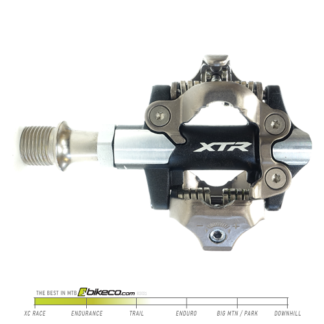
Shimano XTR M9100 Pedals
$180.00In-Stock: updated 04/19/24. Ships same or next business day!
Add to cart -

Time ATAC DH 4 Pedals Black/Red
$106.00Use Inquiry form for product ETA!
Read more -
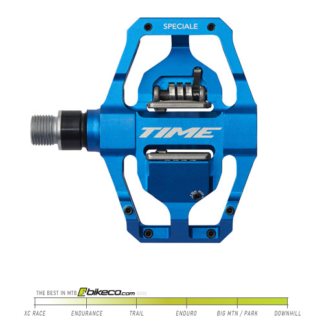
Time Speciale 12 Pedals Blue
$290.00Use Inquiry form for product ETA!
Read more -
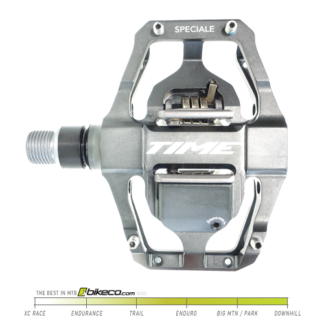
Time Speciale 12 Pedals Gray
$290.00Use Inquiry form for product ETA!
Read more -

Time Speciale 12 Pedals Red
$290.00Use Inquiry form for product ETA!
Read more -
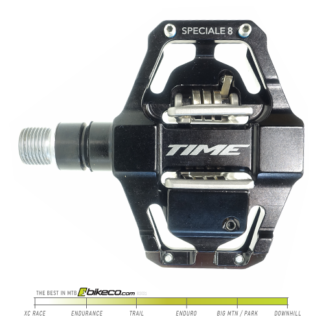
Time SPECIALE 8 Pedals Black
$158.00Use Inquiry form for product ETA!
Read more -

Time SPECIALE 8 Pedals Orange
$158.00Use Inquiry form for product ETA!
Read more
Shopping Flat Pedals
Flat pedals come in a variety of sizes and shapes.
Pedals generally are somewhat “sized” depending on your shoe size. If you’ve got big feet you should shop bigger pedals – makes sense right? (Luckily we list the platform dimensions to help riders compare our selection of platform pedals).

Thinner pedals will slightly improve ground clearance. Thicker pedals may tend to have better bearings for heavier riders.
Some riders prefer more mechanical concave to help sit “into” the pedal.
Hell, some riders love the look and color of a model and that’s enough! We only carry proper pedals so you don’t have to worry about falling in love with a garbage brand or model here at BikeCo.com
-
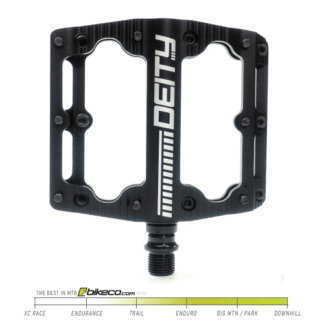
Deity Black Kat Pedals
$119.99Currently Out of Stock - Inquire for Details
Select options -
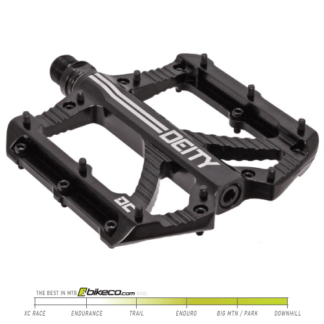
Deity Bladerunner Pedals
$149.99In stock
Select options -
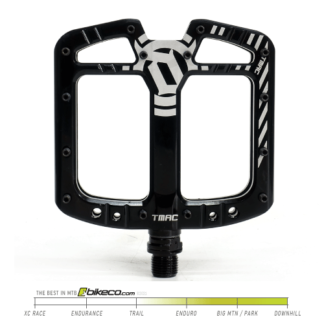
Deity TMAC Pedals
In stock
Read more -

Deity TMAC Pedals (Copy)
In stock
Read more -
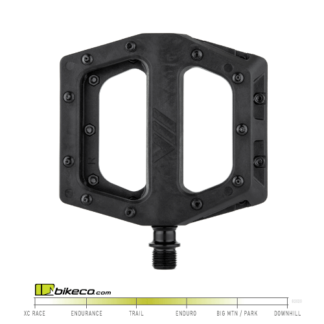
DMR V-11 Composite Pedals
Currently Out of Stock - Inquire for Details
Select options -
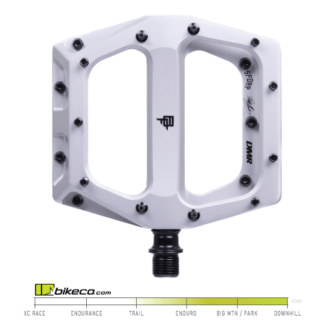
DMR Vault Brendog Ice Pedals
$179.40In-Stock: updated 04/19/24. Ships same or next business day!
Add to cart -

DMR Vault Brendog Stealth Black Pedals
$179.40In-Stock: updated 04/19/24. Ships same or next business day!
Add to cart -
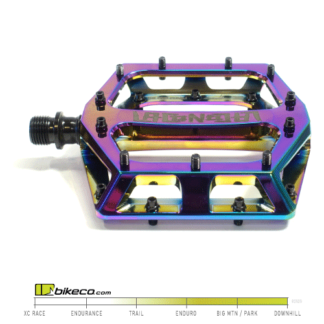
DMR Vault Lacon Oil Slick Pedals
$220.80In-Stock: updated 04/19/24. Ships same or next business day!
Add to cart -

DMR Vault Liquid Camo Grey Pedals
$220.80In-Stock: updated 04/19/24. Ships same or next business day!
Add to cart -
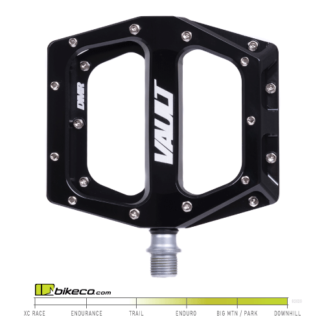
DMR Vault Pedals
Currently Out of Stock - Inquire for Details
Select options -
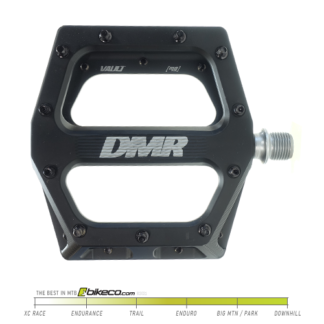
DMR Vault-Mag Black/White Pedals
$165.60Use Inquiry form for product ETA!
Read more -
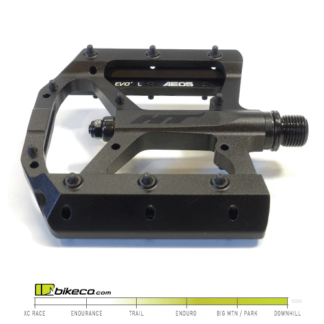
HT AE05 Evo+ Pedals
$165.00Currently Out of Stock - Inquire for Details
Select options
The Worst of Both Worlds
OK, this is a bit of a soapbox rant based mostly on my opinion. Grain of salt if you want – or agree with me and be right! (hahaha, just kidding)
What about pedals that have clips on one side and flats on the other? Well, they’re the worst of both worlds.
Reasons to commit to one or the other:
Clipless side – if you’re trying to clip in and only one side of the pedal has the assembly what are the mathematical odds that it’s facing the correct way? You might think 50% – but you’re wrong. Murphy’s law comes into play and its almost ALWAYS on the bottom and you have to flip the pedal around with your foot till you get it to step into it.
Flat pedal side – ever seen the road biker clippty clomping around the coffee shop and then WHAM!! slipped on the cleat? Ya. Cleats are metal. Metal on hard surfaces tends to be slippery as hell. Clipless shoes have a large area removed to accommodate mounting cleats and allowing them to move forward to back and side to side. So, your clipless shoe with a cleat in it essentially has a big void of traction right near the contact point of your shoe. That means your choices on the platform pedal side are total shit traction, or you can move way forward on the pedal to get to the shoe’s sole around your midfoot or further back. Which isn’t great for control.
Hopefully you’ve learned about the differences between clipless and flats for MTB – we invite you to shop both types of pedals as well as The Best in MTB here on BikeCo.com!
